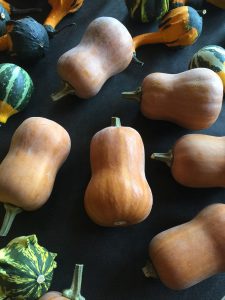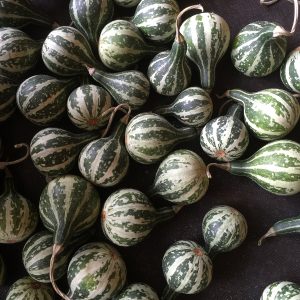At Amy Goldman’s Farm, a Plethora of Pepos
Posted in Learning Experiences on October 31 2016, by Todd Forrest
Todd Forrest is NYBG’s Arthur Ross Vice President for Horticulture and Living Collections. He leads all horticulture programs and activities across the Garden’s 250-acre National Historic Landmark landscape, including 50 gardens and plant collections outside and under glass, the old-growth Thain Family Forest, and living exhibitions in the Enid A. Haupt Conservatory.
 For 47 years, 4 months, and 20 days, I just didn’t know enough about pepos. “What’s a pepo?” you might ask. Pepo is the botanical term for the fruit of plants in the Cucurbitaceae (gourd family). Sure, I knew a little about pumpkins, spaghetti squash, butternut squash, zucchini, and cucumbers. I had eaten Hubbard, acorn, and delicata squash grown, harvested, roasted, and slathered in butter by my brother-in-law, a gourmand who farms in coastal Maine. I even knew that the luffa defoliators my fresh-faced friends swear by are made from the dried fibrous flesh of a gourd relative native to Africa.
For 47 years, 4 months, and 20 days, I just didn’t know enough about pepos. “What’s a pepo?” you might ask. Pepo is the botanical term for the fruit of plants in the Cucurbitaceae (gourd family). Sure, I knew a little about pumpkins, spaghetti squash, butternut squash, zucchini, and cucumbers. I had eaten Hubbard, acorn, and delicata squash grown, harvested, roasted, and slathered in butter by my brother-in-law, a gourmand who farms in coastal Maine. I even knew that the luffa defoliators my fresh-faced friends swear by are made from the dried fibrous flesh of a gourd relative native to Africa.
The little I thought I knew about pepos could never have prepared me for the bounty of beauty I encountered when I made the journey, with a group of NYBG trustees and staff members, to NYBG Board Member Amy Goldman Fowler’s farm in the Hudson Valley one glorious October day. Amy has raised the art and science of growing vegetables to a level unimaginable to those of us who tinker in backyard plots. With the discipline of a research scientist and the passion of an artist, Amy grows a bewildering selection of melons, squash, pumpkins, and gourds (not to mention tomatoes and peppers and who knows what else) on her farm each year.
[Not a valid template]
When we arrived, this year’s harvest of squash, pumpkins, and gourds was laid out to cure on tables in a barn near one of Amy’s fields. Each table was covered in black cloth, which provided the perfect backdrop for a cheerful and colorful array of pepos in every shape and size. There were two-tiered ‘Turk’s Turban’ squash, preciously diminutive ‘Jack Be Little’ pumpkins, ‘Bicolor Pear’ gourds that looked as if they had been half-dipped in black dye, dark green ‘Table Queen’ squash, Robin’s egg-blue pumpkins flecked with splashes of creamy pink, hard-shelled gourds of every size and shape, no fewer than four strains of butternut squash, and an embarrassment of bizarrely bumpy and ridged ‘Autumn Wings’ gourds.
 It takes a serious gardener to produce such a wide range of perfectly grown cucurbits.
It takes a serious gardener to produce such a wide range of perfectly grown cucurbits.
This year, Amy grew 130 different squash (which include summer squash, winter squash, and pumpkins), 40 hard-shell gourds, 30 melons, and 12 watermelons. She even grew some ‘Dill’s Atlantic Giant’ pumpkins, the same variety that competitive giant pumpkin growers like the Wallaces of Rhode Island plant as they chase the world record. While hers didn’t quite hit the two-ton mark, they were the perfect complement to the adorable green-and-white striped ‘Tennessee Spinning’ gourds, which would fit in the palm of a child’s hand.
She grew all of these pepos to marvel at, to eat, to share with friends, and for Victor Schrager to photograph for a significantly expanded edition of her classic book The Compleat Squash, which will be published in a year or two. This edition will feature new varieties of gourds and squash, new photographs, and even new recipes. To our delight, Amy prepared us lunch using some of these recipes. If my completely clean plate is any indication, Amy’s squash dishes may even trump the photographs as my favorite part of the book.

